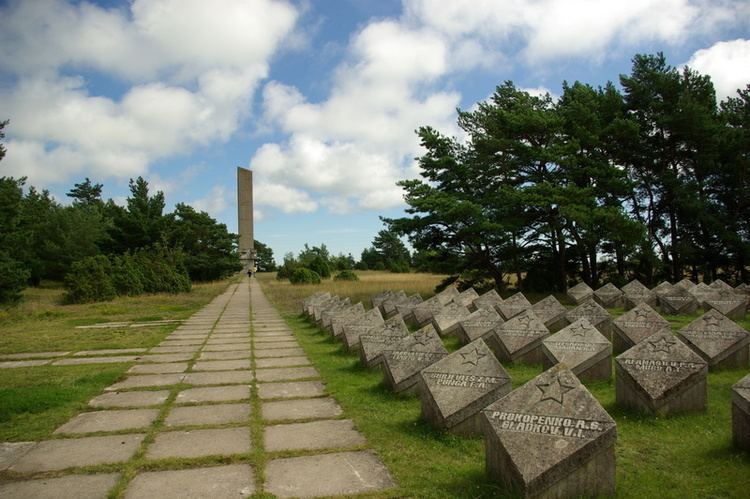Start date October 8, 1944 | ||
 | ||
Similar Battle of Porkuni, Tartu Offensive, Estonia in World War II, Battle of Narva, Battle of Tannenberg Line | ||
The Battle of Tehumardi (Estonian: Tehumardi öölahing, Russian: Бой у Техумарди, German Schlacht von Tehumardi) was one of the most brutal engagements during the fighting on the Estonian island of Saaremaa (Oesel) in 1944.
Contents
Background
The Soviet Moonsund Landing Operation on 29 September 1944 had quickly gained ground. The smaller island of Muhu (Moon) was given up with little organized resistance, as was Hiiumaa (Dago). On 5 October, the Russians landed on Saaremaa. In a reversal of the fighting in 1941, the Germans conducted a quick fighting withdrawal, and planned to make a stand on the easily defendable peninsula of Sõrve (Sworbe).
German forces
Two infantry battalions from the German 67th Potsdam Grenadier Regiment from the 23rd Infantry Division (Wehrmacht) had occupied a defensive position on the Nasva river, just West of the city of Kuressaare (Arensburg). They were a part of Kampfgruppe Eulenburg, most of which already had taken up positions on the Sõrve peninsula. The first and second battalions were commanded by Hauptmaenner (Captains) H. Ulrichs and Klaus Ritter, respectively. Together, the reduced battalions mustered about 700-750 men. As they were unable to communicate with their parent unit and they felt increasingly isolated, towards midnight on the 8th the order was given to retreat to Sõrve.
Russian forces
Meanwhile, bypassing the German position on the Nasva, Russian units moved south to occupy positions astride the main road leading to the peninsula. These were elements of the 307th anti-tank Battalion from the Estonian 249th Rifle Division, about 370 men commanded by Major V. Miller. Later that evening, they were joined by the 1st battalion of the 917th regiment, approximately 300 men commanded by Major G. Karaulnov, advancing down a secondary road leading to the small village of Tehumardi, right before the bottleneck of the peninsula. Many of the soldiers in the Russian units were forcibly conscripted Estonians. Due to lack of reconnaissance, the Russians were unaware of the withdrawing German units, and the stage was set for a confused night battle when the forces met head-on.
The battle
The Germans' fear of being stragglers soon proved correct, as the only road already had been cratered by other withdrawing German units. Bypassing this obstacle took some time, the vehicles were slowly pulled across with the help of a recently captured US-made M3 Stuart light tank. Suspecting an enemy presence, the soldiers were ordered to keep as silent as possible, breaking through the enemy positions with a sudden attack. The two battalions split up, the 1st moving along the waterline, the 2nd moving along the main road in parallel, about 200 m distant. Soon the 2nd found themselves marching along a Russian unit, who believing them to be fellow Russians, gave way. Flares fired gave the game away, and battle was joined. The Russians, the 1st battalion of the 917th was quickly overwhelmed, but the Germans then ran into the anti-tank positions of the 370th. The battle degenerated into chaotic hand-to-hand combat in the darkness with heavy losses on both sides, but the Germans broke through. Their actions kept the Russians occupied, however, and the 1st battalion moving along the waterline took no part in the fighting and suffered no losses.
Aftermath
The majority of the Germans were able to break through to join the defence of the Sõrve peninsula, but almost 200 men had been lost. Captured German soldiers were shot, as happened consistently during the fighting on the island. Most of the vehicles were also left behind, including the light tank and a self-propelled FlaK gun. The Russians also suffered about 200 men killed, with an unknown number of wounded. The killed included the commander, Major V. Miller. At least one tank and several guns were also knocked out.
The action delayed the Russian attack on the peninsula, giving the Germans more time to improve their defences. But the hard-pressed German forces could ill afford losses in equipment and manpower at this stage of the war. After several weeks more of bitter fighting, the Sõrve peninsula, and thereby the entire island of Saaremaa, was evacuated by the Germans on the 23/24 November.
After the war
To commemorate the battle, in 1967 the Russians raised a gigantic, typical Soviet-style, monument, sword-shaped and made of concrete and dolomite. Several massive concrete slabs with names of the fallen Russians are mounted nearby. Most Russians were buried on the site.
Little care was given to the fallen Germans; as a consequence, most remain missing.
